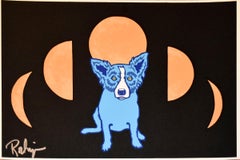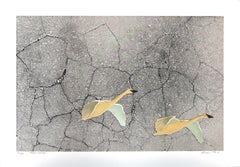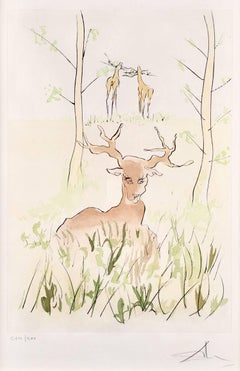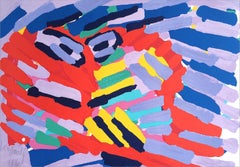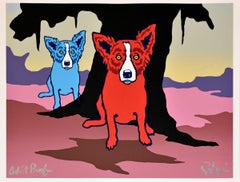20th Century Animal Prints
to
450
1,000
486
747
323
94
Overall Width
to
Overall Height
to
617
376
278
256
111
102
46
36
33
7
5
4
3
2
148
101
62
50
49
694
1,424
2,656
1,859
34
29
64
164
100
155
242
631
357
320
660
1,430
1,155
53
1,029
718
543
516
427
373
250
240
217
205
176
148
133
100
91
90
88
83
75
73
1,286
569
354
258
124
347
743
1,671
772
Period: 20th Century
Blue Phases - Signed Silkscreen Print
Located in Mount Laurel, NJ
This Blue Dog work consists of a black background with the phases of the moon above a single blue dog sitting in the center. The dog has soulful yellow eyes. This pop art animal original silkscreen...
Category
Pop Art 20th Century Animal Prints
Materials
Screen
"Brave Venture" original lithograph signed pop art dystopian dark abstract birds
Located in Milwaukee, WI
"Brave Venture" is an original color lithograph by Michael Knigin. The artist signed the piece lower right, titled it lower left, and wrote the edition number (142/300) in the lower ...
Category
Pop Art 20th Century Animal Prints
Materials
Lithograph
Salvador Dalí, "Le Cerf Malade" from Le Bestiaire de la Fontaine, engraving
Located in Chatsworth, CA
This piece is an original engraving with color added by pochoir by Salvador Dali. It is from Dali's suite of 12 original engravings entitled "Le Bestiaire de la Fontaine", which he c...
Category
Surrealist 20th Century Animal Prints
Materials
Engraving
BIG HEAD RED LAVENDER Signed Lithograph, Abstract Animal, CoBrA Artist
By Karel Appel
Located in Union City, NJ
BIG HEAD RED LAVENDER is an original limited edition lithograph by the Dutch artist Karel Appel on printed using traditional hand lithography techniques on archival printmaking paper...
Category
Abstract 20th Century Animal Prints
Materials
Lithograph
$1,224 Sale Price
30% Off
Nude Woman with Cat
Located in San Francisco, CA
This artwork "Nude Woman with Cat" c.1990, is an original colors etching with aquatint on Wove paper by noted Mexican artist Jose Esteban Martinez, b.1951. It is hand signed in penci...
Category
Other Art Style 20th Century Animal Prints
Materials
Etching, Aquatint
Don't Like Bein' Blue - Split Font - Signed Silkscreen Print - Blue Dog
Located in Mount Laurel, NJ
This Blue Dog work consists of a background of gray, yellow, purple, and 2 shades of pink with a black tree. to the left of the tree is a blue dog and forward is a red dog with a sh...
Category
Pop Art 20th Century Animal Prints
Materials
Screen
DEER IN A CLEAR CUT
Located in Aventura, FL
Lithograph on paper. Hand signed, titled and numbered by the artist. Edition of 350.
Artwork is in excellent condition. Certificate of Authenticity is included. All reasonable o...
Category
Realist 20th Century Animal Prints
Materials
Paper, Lithograph
$150 Sale Price
50% Off
VINTAGE POSTER - Original Lithograph : Collas Coffee (India) - Elephant - 1927
Located in Paris, IDF
ANONYMOUS (20th century)
Café Collas, Pearls of the Indies, 1927
Original lithograph poster (La Semeuse workshop)
On paper, 113 x 74 cm (c. 45 x 30 in)
INFORMATION: Beautiful vinta...
Category
Art Deco 20th Century Animal Prints
Materials
Lithograph
'Horse with Jugglers' 1965-
Located in Brooklyn, NY
Printed in 1965 by Franz Hanfstaengl in Munich, Germany. The Marini bears the printer's blind stamp just below the bottom left-hand corner of the image, which reads "Hansfstaengldru...
Category
Contemporary 20th Century Animal Prints
Materials
Offset
$300 Sale Price
20% Off
Harrison Begay Pair of Deer
Located in San Francisco, CA
Harrison Begay: 1917-2012. Listed American Indian painter and printmaker. His given Navajo name was Haashke yah Niya. His screen prints have sold at auc...
Category
20th Century Animal Prints
Materials
Screen
Alexander Calder Circus Reproduction Lithograph After a Drawing
Located in Surfside, FL
(after) Alexander Calder
"Calder's Circus" offset lithograph on wove paper after drawings by the artist
Published by Art in America and Perls gallery in 1964 (from drawings done in t...
Category
American Modern 20th Century Animal Prints
Materials
Lithograph
Les Courses -L'obstacle/de coté Horse Race, Pointillist style Equestrian print
Located in Spokane, WA
Colorful Lithograph of Horse Race – Jockey on Norse No. 6 by Serge Medjisky, original poster: Linen-backed printer's proof without text of the horse race. In the lower right are the ...
Category
Impressionist 20th Century Animal Prints
Materials
Lithograph
Original Agricoltori! Tafanoide - Equestrian vintage Italian poster
Located in Spokane, WA
Original Agricoltori Tafanoide Italian vintage poster. Linen-backed and in good condition with edge wear. Colors are still bright and vibrant.
Museum linen backed. This is a good pi...
Category
American Realist 20th Century Animal Prints
Materials
Lithograph
$660 Sale Price
20% Off
Owl, American Realist Poster by Erwin Rambow
Located in Long Island City, NY
Erwin Rambow, American (1925 - 2013) - Owl, Medium: Poster, Image Size: 15 x 15 inches, Size: 19.5 x 15.5 in. (49.53 x 39.37 cm), Frame Size: 21.5 x 17.75 inches
Category
American Realist 20th Century Animal Prints
Materials
Offset
$112 Sale Price
25% Off
Artiste Animaliers, Art Nouveau Poster by Theophile Alexandre Steinlen
Located in Long Island City, NY
Theophile Alexandre Steinlen, French/Swiss (1859 - 1923) - Artiste Animaliers, Year: 1981, Medium: Poster with Embossed Cat Blindstamp, Size: 20.5 x 25 in. (52.07 x 63.5 cm), Prin...
Category
Art Nouveau 20th Century Animal Prints
Materials
Offset
Tiger and Python by Orovida Pissarro, 1917 - Etching Print
Located in London, GB
SOLD UNFRAMED
Tiger and Python by Orovida Pissarro (1893 - 1968)
Etching
22.5 x 27 cm (8 ⅞ x 10 ⅝ inches)
Signed, inscribed with title and dated 1917
State 1, no. 9/10
Provenance...
Category
20th Century Animal Prints
Materials
Etching
Through the Storm.
Located in Storrs, CT
Appleby 97. 4 x 6 15/16 (sheet 8 1/8 x 10 3/8). Edition 100. A rich impression with drypoint burr and carefully wiped plate tone, printed on 'FJ Head' paper, on the full sheet with ...
Category
Modern 20th Century Animal Prints
Materials
Drypoint, Etching
Large Classical Bird Color Print After John James Audubon, American Magpie
Located in Cirencester, Gloucestershire
Classical bird print,
after John James Audubon,
printed by Harry N. Abrams, Publishers, New York
unframed, 17 x 14 inches color print on paper
condition: very good
provenance: from...
Category
Victorian 20th Century Animal Prints
Materials
Acrylic
Large Classical Bird Color Print after John James Audubon -Iceland Or Ler Falcon
Located in Cirencester, Gloucestershire
Classical Bird print,
after John James Audubon,
printed by Harry N. Abrams, Publishers, New York
unframed, 17 x 14 inches color print on paper
condition: very good
provenance: from...
Category
Victorian 20th Century Animal Prints
Materials
Acrylic
Large Classical Bird Color Print after John James Audubon, Summer or Woodduck
Located in Cirencester, Gloucestershire
Classical Bird print,
after John James Audubon,
printed by Harry N. Abrams, Publishers, New York
unframed, 17 x 14 inches color print on paper
condition: very good
provenance: from...
Category
Victorian 20th Century Animal Prints
Materials
Acrylic
Large Classical Bird Color Print after John James Audubon, Canada Jay
Located in Cirencester, Gloucestershire
Classical Bird print,
after John James Audubon,
printed by Harry N. Abrams, Publishers, New York
unframed, 17 x 14 inches color print on paper
condition: very good
provenance: from...
Category
Victorian 20th Century Animal Prints
Materials
Acrylic
Large Classical Bird Color Print after John James Audubon, Brown Pelican
Located in Cirencester, Gloucestershire
Classical Bird print,
after John James Audubon,
printed by Harry N. Abrams, Publishers, New York
unframed, 17 x 14 inches color print on paper
condition: very good
provenance: from...
Category
Victorian 20th Century Animal Prints
Materials
Acrylic
Classic Bird Color Prints x 3, Beautiful Set of 3 Classical Birds
Located in Cirencester, Gloucestershire
Set of 3 Colored Bird Prints
each unframed, 10.5 x 14.5 inches
condition: very good
A beautiful set of 3 colored prints of classical birds in landscape settings. As a set, they make...
Category
20th Century Animal Prints
Materials
Acrylic
Large Classical Bird Color Print After John James Audubon, Wild Turkey
Located in Cirencester, Gloucestershire
Classical Bird print,
after John James Audubon,
printed by Harry N. Abrams, Publishers, New York
unframed, 17 x 14 inches color print on paper
condition: very good
provenance: from...
Category
Victorian 20th Century Animal Prints
Materials
Acrylic
Large Classical Bird Color Print after John James Audubon, Broad Winged Hawk
Located in Cirencester, Gloucestershire
Classical Bird print,
after John James Audubon,
printed by Harry N. Abrams, Publishers, New York
unframed, 17 x 14 inches color print on paper
condition: very good
provenance: from...
Category
Victorian 20th Century Animal Prints
Materials
Acrylic
MAMELOUK ENLEVANT UNE FEMME, ATTAQUE PAR UN MOUSQUETAIRE (BLOCH 1586)
Located in Aventura, FL
Aquatint on wove paper. Hand signed and numbered by Pablo Picasso. Plate 106, from the serie "347 gravures" (B. 1586; BA. 1602 II B b 1). Published by Galerie Louise Leiris, Paris. ...
Category
Cubist 20th Century Animal Prints
Materials
Paper, Engraving
$15,600 Sale Price
20% Off
Mare and Foal by Orovida Pissarro - Etching Print
Located in London, GB
SOLD UNFRAMED
Mare and Foal by Orovida Pissarro (1893 - 1968)
Etching
15.6 x 20.7 cm (6 ¹/₈ x 8 ¹/₈ inches)
Artist's Biography
Orovida Camille Pissarro, Lucien and Esther Pissarr...
Category
20th Century Animal Prints
Materials
Etching
I See You, You See Me Split Font - Signed Silkscreen Blue Dog Print
Located in Mount Laurel, NJ
This Blue Dog work consists of a background of white and red with a lot of soulful yellow eyes of various sizes and 1 blue dog off-centered on the right. the dog also has soulful yel...
Category
Pop Art 20th Century Animal Prints
Materials
Screen
From the suite "Les Fables De La Fontaine" original etching
By Marc Chagall
Located in San Francisco, CA
Artist: Marc Chagall (Russian, 1887-1985)
Title: From the suite "Les Fables De La Fontaine"
Year: 1927
Medium: Original etching
Edition: fom...
Category
Modern 20th Century Animal Prints
Materials
Etching
Three D - Signed Silkscreen Blue Dog Print
Located in Mount Laurel, NJ
This Blue Dog work consists of 3 dogs each framed in black with multiple backgrounds. One dog is sitting on a purple moon with a black background, 1 dog is sitting behind an olive colored orb with a darker green tree and a light green background, and 1 dog is dressed in a red cape sitting atop 3 orange...
Category
Pop Art 20th Century Animal Prints
Materials
Screen
Blue Dog "Morning Glories with Tiffany 3" Signed Numbered Silkscreen Print
Located in Mount Laurel, NJ
This Blue Dog work consists of a blonde female sitting on a floral swing hanging from a tree. The female is wearing an ecru dress with flowers on the edges...
Category
Pop Art 20th Century Animal Prints
Materials
Screen
Oiseaux Souterrains, Signed Modern Bird Lithograph by Max Ernst
By Max Ernst
Located in Long Island City, NY
Artist: Max Ernst, German (1891 - 1976)
Title: Oiseaux Souterrains
Year: 1975
Medium: Lithograph on Japon paper, signed and numbered in pencil
Edition: 99
Image Size: 13.5 x 24.5 inc...
Category
Surrealist 20th Century Animal Prints
Materials
Lithograph
The Dove, Modern Lithograph by Emile Gilioli
Located in Long Island City, NY
An original hand-signed limited edition lithograph by famed sculptor Emile Gilioli. Edition of only 75. Émile Gilioli (b. Paris, 10 June 1911, d. Paris,...
Category
Modern 20th Century Animal Prints
Materials
Lithograph
Griffon A Poil Laineux, French hound dog chromolithograph print, 1931
By P. Mahler
Located in Melbourne, Victoria
French chromolithograph, published in 1931. Signed by artist in the plate. Printed title lower right of sheet. Plate number top right. From a French series of illustrations of sporti...
Category
Art Deco 20th Century Animal Prints
Materials
Lithograph
Pekingnese, Chow and Spaniel, Cecil Aldin 1930s puppy dog lithograph
Located in Melbourne, Victoria
'Pekingnese, Chow and Spaniel'
Cecil Aldin dog lithograph, 1935.
Cecil Aldin was a British artist and illustrator best known for his paintings and sketches of animals, sports, and ...
Category
English School 20th Century Animal Prints
Materials
Lithograph
Course de Taureaux, Cubist Lithograph after Pablo Picasso
Located in Long Island City, NY
Comprised of shapes with lines and sharp angles, this composition depicting the running of the bulls is hectic and energized. Rendered in gradiated rainbow colors, the animals in thi...
Category
Cubist 20th Century Animal Prints
Materials
Lithograph
Wood Duck, American Realist Lithograph by Chris Forrest
Located in Long Island City, NY
Chris Forrest, American (1946 - ) - Wood Duck, Year: circa 1979, Medium: Lithograph, Signed and numbered in pencil, Edition: 300, AP 40, Size: 29 in....
Category
American Realist 20th Century Animal Prints
Materials
Lithograph
Elephant, Lions Bold Color Lithograph Alexander Calder Unfinished Revolution
Located in Surfside, FL
1975 Color Lithograph by Alexander Calder
from Our Unfinished Revolution portfolio
One of 250 copies, with the printed signature and date on offset paper.
This is not pencil signed ...
Category
American Modern 20th Century Animal Prints
Materials
Lithograph
Don't Like Bein' Blue White - Signed Silkscreen Blue Dog Print
Located in Mount Laurel, NJ
This Blue Dog work consists of 2 dogs on a white background; a red dog in the foreground and a blue dog behind and to the left of a black tree in the background. Both dogs have soul...
Category
Pop Art 20th Century Animal Prints
Materials
Screen
Landscape with Deer Herds
By Hoi Lebadang
Located in San Francisco, CA
This artwork "Landscape with Deer Herds" c.1970 is an original color lithograph by French/Vietnamese artist Hoi Lebadang, 1922-2015. It is hand sig...
Category
Modern 20th Century Animal Prints
Materials
Lithograph
Bears a Resemblance Black - Signed Silkscreen Print
Located in Mount Laurel, NJ
This Blue Dog work consists of a black background with a red triangle. There are 3 blue bears, one on each point of the triangle. There is a blue dog bottom center dressed in a wh...
Category
Pop Art 20th Century Animal Prints
Materials
Screen
Pink Cat, CoBrA Group Modern Lithograph by Karel Appel
By Karel Appel
Located in Long Island City, NY
This signed and numbered lithograph on Japon paper is from a portfolio of 17 prints by Modern artist Karel Appel. He admired the domestic house cat for its aloof, yet instinctive, de...
Category
Modern 20th Century Animal Prints
Materials
Lithograph
Blue Dog "Three's Company - Black"
Located in Mount Laurel, NJ
This Blue Dog work consists of a black background with 3 dogs, 1 each white, blue and red. All the dogs have soulful yellow eyes. This pop art animal original silkscreen print on p...
Category
Pop Art 20th Century Animal Prints
Materials
Screen
Zebra and foal by Orovida Pissarro - Animal etching
Located in London, GB
Zebra and foal by Orovida Pissarro (1893-1968)
Etching
20 x 17.3 cm (7⁷/₈ x 6³/₄ inches)
Signed and dated lower right Orovida 1938
Titled lower middle and numbered 4/50 lower right
...
Category
20th Century Animal Prints
Materials
Etching
"Unicorn Moebius II" - Trial Proof Lithograph in Ink on Laid Paper
Located in Soquel, CA
"Unicorn Moebius II" - Trial Proof Lithograph in Ink on Laid Paper
High contrast, multi-layer etching by Bruce Weinberg (American, 1942-1994). A moebius strip is shown against a dar...
Category
American Modern 20th Century Animal Prints
Materials
Laid Paper, Lithograph
$1,202 Sale Price
35% Off
WHITE ICONS (COMPLETE SERIES OF 5)
By Keith Haring
Located in Aventura, FL
Embossing on arches cover paper. Published by Tony Shafrazi Editions. Printed by Studio Heinrici, LTD. NYC. Littmann pp. 172-173. Each hand signed, dated and numbered on verso by ...
Category
Pop Art 20th Century Animal Prints
Materials
Paper, Screen
BLACK BEAR IN THE CHICKCHOCS
Located in Aventura, FL
Lithograph on paper. Hand signed, titled and numbered by the artist. Edition of 350.
Artwork is in excellent condition. Certificate of Authenticity is included. All reasonable o...
Category
Realist 20th Century Animal Prints
Materials
Paper, Lithograph
$150 Sale Price
50% Off
Earth Day
Located in Naples, Florida
In response to a massive oil spill off the coast of Southern California in 1969, Wisconsin Senator Gaylord Nelson initiated the idea of the first annual Earth Day on April 22, 1970, ...
Category
20th Century Animal Prints
Materials
Lithograph
The Gull
Located in Fairlawn, OH
Signed, dated, titled in pencil by the artist; Annotated "To Jon from Ray"
Reproduced in the artists Retrospective Exhibition catalogue.
In the collection of the Wichita Art...
Category
20th Century Animal Prints
Materials
Engraving
Michael Knigin, Golden Eagle, 1979, lithograph
Located in New York, NY
Michael Knigin, an extremely skilled draftsman, rides a fine line between realism and surrealism. Here he has conceived of an elegant and emotional eagle, a national symbol. In stark...
Category
Contemporary 20th Century Animal Prints
Materials
Lithograph
Shepherdess and her Sheep - Original wooodcut, Handsigned & Numbered
Located in Paris, IDF
Henri AMEDEE-WETTER (1869-1929)
Shepherdess and her Sheep, 1920
Original woodcut
Handsigned in pencil
Numbered /105
On vellum 32.5 x 25.5 cm (c. 13 x 10 in)
Bears the blind stamp of...
Category
Modern 20th Century Animal Prints
Materials
Woodcut
Snow Owl, American Realist Lithograph by Chris Forrest
Located in Long Island City, NY
Chris Forrest, American (1946 - ) - Snow Owl, Year: 1980, Medium: Lithograph, signed and numbered in pencil, Edition: 300, AP XL, Image Size: 22 x 18 inches, Size: 23 in. x 29 i...
Category
American Realist 20th Century Animal Prints
Materials
Lithograph
Polo Fields, American Realist Screenprint by Harry Schaare
Located in Long Island City, NY
Harry Schaare, American (1922 - 2008) - Polo Fields, Year: circa 1976, Medium: Screenprint, signed and numbered in pencil, Edition: 300, AP 50, Size: 28 x 36 in. (71.12 x 91.44...
Category
American Realist 20th Century Animal Prints
Materials
Screen
SPACE VOYAGE Signed Lithograph, Abstract Beings, Latin American Woman Artist
Located in Union City, NJ
SPACE VOYAGE is an original hand drawn lithograph by the Latin American Woman artist Raquel Forner(1902–1988) , paper size - 13 1/4 x 15 1/4 in., image size - 8 1/2 x 11 3/4 in. pri...
Category
Expressionist 20th Century Animal Prints
Materials
Lithograph
It's Party Time - Signed Silkscreen Blue Dog Print
Located in Mount Laurel, NJ
This Blue Dog work consists of 1 dog of varying shades of pinks and blues. There are several lines of yellow, red, pink, white and blue etched around the figure of the dog. The dog ...
Category
Pop Art 20th Century Animal Prints
Materials
Screen
Common Shelduck, French antique natural history bird duck art illustration print
By P. Mahler
Located in Melbourne, Victoria
'Canard Tadorne'
(Common Shelduck)
French chromolithograph, published in 1931. Printed title lower right of sheet. Plate number top right. From a French series of illustrations of ...
Category
Art Deco 20th Century Animal Prints
Materials
Lithograph
Print by Georges Manzana Pissarro 'La Bergère Turque' (The Turkish Shepherdess)
Located in London, GB
'La Bergère Turque' (The Turkish Shepherdess) by Georges Manzana Pissarro (1871-1961)
Etching
33.5 x 27 cm (13 ¼ x 10 ¾ inches)
Signed lower left, Manzana Pissarro, titled and inscri...
Category
Post-Impressionist 20th Century Animal Prints
Materials
Etching
White Herons, Impressionist Lithograph by David Lee
Located in Long Island City, NY
David Lee, Chinese (1944 - ) - White Herons, Year: circa 1985, Medium: Lithograph, signed and numbered in pencil, Edition: 100, Size: 21 x 29 in. (53.34 x 73.66 cm), Descriptio...
Category
Impressionist 20th Century Animal Prints
Materials
Lithograph
Fox Hound, French hound dog chromolithograph print, 1931
By P. Mahler
Located in Melbourne, Victoria
French chromolithograph, published in 1931. Signed by artist in the plate. Printed title lower right of sheet. Plate number top right. From a French series of illustrations of sporti...
Category
Art Deco 20th Century Animal Prints
Materials
Lithograph
The Obscure Fable, by Stan Washburn
Located in Palm Springs, CA
Signed, titled and numbered etching from the edition of 120. In individual prints, and in his illustrated books, Washburn cleverly skewers human frailties with Renaissance-style engravings and tongue-in-cheek wit. This image of a rhinoceros and a lamb, hints at an imaginary fable similar to the lion and the lamb.
Stan Washburn...
Category
Contemporary 20th Century Animal Prints
Materials
Etching
